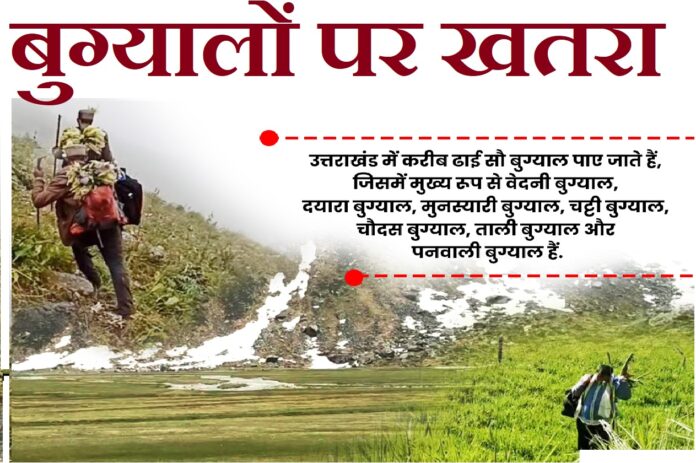Mohan Bhulani, NTI: The area between the snow line and the tree line in the high Himalayas plays a crucial role in maintaining the ecosystem’s balance. This region, located between an altitude of 3,500 to 4,500 meters, is considered the “thermometer” of environmental health. However, over the past few decades, the health of the alpine meadows (locally known as bugyals) has been deteriorating, and a significant portion of these grasslands is being destroyed. The causes of this degradation are not purely natural; human intervention in these regions has also significantly altered the landscape.
The Importance of Bugyals and the Increasing Pressure on Them:
There are several vast grasslands in the lower regions of the high Himalayas. If we compare the Himalayan ecosystem to a human body, the snow-capped peaks are like the head, and the grasslands can be seen as the neck region. These grasslands are considered a vital part of the Himalayan ecology. From Uttarakhand in the Western Himalayas to Afghanistan, many areas are home to bugyals, although they are known by different names in different regions. For instance, in Jammu and Kashmir, there are large grasslands like Gulmarg, while several districts in Uttarakhand are rich in extensive alpine meadows.
The streams that originate from glaciers in the Himalayas flow through these bugyals, eventually forming rivers. As the water passes through these bugyals, it absorbs the medicinal properties of various herbs, enhancing the rivers with healing qualities.
Threats to 10% of High Himalayan Grasslands:
The pressure on these grasslands has been steadily increasing over the past few decades. This pressure is not just due to natural causes but also results from human activities. Climate change has caused these grasslands to shrink, and there is significant soil erosion in these areas. Additionally, landslides have altered the landscape of these meadows. Flash floods, like cloudbursts, have also contributed to the reduction of bugyals. Besides natural causes, human activities such as camping for tourism, grazing livestock in the meadows, illegal harvesting of medicinal herbs, and plastic waste from tourism have all posed significant threats to these alpine grasslands.
Eco-Friendly Technology Creating Employment Opportunities:
The use of eco-friendly technology has provided employment opportunities for local communities. The Forest Department is utilizing this technology to identify and restore affected areas. Bugyal treatment programs are underway in all 13 divisions of the state. While a major threat looms over these grasslands, the Forest Department is working hard to save these vast meadows. The good news is that the eco-friendly technology being employed is yielding positive results, and the Forest Department is optimistic about the outcome.


